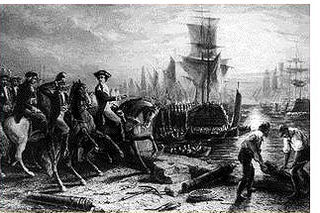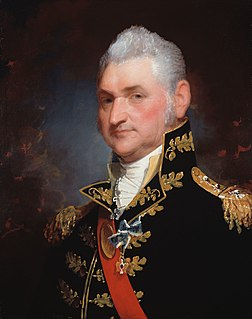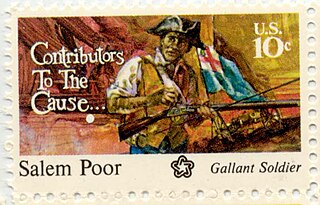
Israel Putnam, popularly known as "Old Put", was an American army general officer who fought with distinction at the Battle of Bunker Hill during the American Revolutionary War (1775–1783). He also served notably as an officer with Rogers' Rangers during the French and Indian War (1754–1763), when he was captured by Mohawk warriors. He was saved from the ritual burning given to enemies by the intervention of a French officer with whom the Mohawk were allied.

The Battle of Bunker Hill was fought on Saturday, June 17, 1775, during the Siege of Boston in the first stage of the American Revolutionary War. The battle is named after Bunker Hill in Charlestown, Massachusetts, which was peripherally involved in the battle. It was the original objective of both the colonial and British troops, though the majority of combat took place on the adjacent hill which later became known as Breed's Hill.

John Stark was a New Hampshire native who served as an officer in the British Army during the French and Indian war and a major general in the Continental Army during the American Revolution. He became widely known as the "Hero of Bennington" for his exemplary service at the Battle of Bennington in 1777.

The siege of Boston was the opening phase of the American Revolutionary War. New England militiamen prevented the movement by land of the British Army, which was garrisoned in what was then the peninsular city of Boston, Massachusetts Bay. Both sides had to deal with resource, supply, and personnel issues over the course of the siege. British resupply and reinforcement was limited to sea access, which was impeded by American vessels. The British abandoned Boston after eleven months and transferred their troops and equipment to Nova Scotia.

Henry Dearborn was an American military officer and politician. In the Revolutionary War, he served under Benedict Arnold in his expedition to Quebec, of which his journal provides an important record. After being captured and exchanged, he served in George Washington's Continental Army. He was present at the British surrender at Yorktown. Dearborn served on General George Washington's staff in Virginia.

William Prescott was an American colonel in the Revolutionary War who commanded the patriot forces in the Battle of Bunker Hill. Prescott is known for his order to his soldiers, "Do not fire until you see the whites of their eyes", such that the rebel troops may shoot at the enemy at shorter ranges, and therefore more accurately and lethally, and so conserve their limited stocks of ammunition. It is debated whether Prescott or someone earlier coined this memorable saying.

Charlestown is the oldest neighborhood in Boston, Massachusetts. Originally called Mishawum by the Massachusett tribe, it is located on a peninsula north of the Charles River, across from downtown Boston, and also adjoins the Mystic River and Boston Harbor waterways. Charlestown was laid out in 1629 by engineer Thomas Graves, one of its earliest settlers, in the reign of Charles I of England. It was originally a separate town and the first capital of the Massachusetts Bay Colony.

Joseph Warren was an American physician who played a leading role in Patriot organizations in Boston during the early days of the American Revolution, eventually serving as President of the revolutionary Massachusetts Provincial Congress. Warren enlisted Paul Revere and William Dawes on April 18, 1775, to leave Boston and spread the alarm that the British garrison in Boston was setting out to raid the town of Concord and arrest rebel leaders John Hancock and Samuel Adams. Warren participated in the Battles of Lexington and Concord the following day, which are commonly considered to be the opening engagements of the American Revolutionary War.

Lieutenant Colonel James Abercrombie was a British army officer who died during the American Revolutionary War.

Salem Poor (1747–1802) was an enslaved African-American man who purchased his freedom in 1769, became a soldier in 1775, and rose to fame as a war hero during the American Revolutionary War, particularly in the Battle of Bunker Hill.

The Bunker Hill Monument is a monument erected at the site of the Battle of Bunker Hill in Boston, Massachusetts, which was among the first major battles between British and Patriot forces in the American Revolutionary War. The 221-foot granite obelisk was erected between 1825 and 1843 in Charlestown, Massachusetts, with granite from nearby Quincy conveyed to the site via the purpose-built Granite Railway, followed by a trip by barge. There are 294 steps to the top.

Thomas W. Knowlton was an American patriot who served in the French and Indian War and was a colonel during the American Revolution. Knowlton is considered America's first Intelligence professional, and his unit, Knowlton's Rangers, gathered intelligence during the early Revolutionary War. Knowlton was killed in action at the Battle of Harlem Heights.

The Boston campaign was the opening campaign of the American Revolutionary War, taking place primarily in the Province of Massachusetts Bay. The campaign began with the Battles of Lexington and Concord on April 19, 1775, in which the local colonial militias interdicted a British government attempt to seize military stores and leaders in Concord, Massachusetts. The entire British expedition suffered significant casualties during a running battle back to Charlestown against an ever-growing number of militia.

The Fortification of Dorchester Heights was a decisive action early in the American Revolutionary War that precipitated the end of the siege of Boston and the withdrawal of British troops from that city.
The 3rd New Hampshire Regiment, also known as the 2nd Continental Regiment, was authorized on 22 May 1775, organized 1–8 June 1775, and adopted into the Continental Army on 14 June 1775, as the third of three regiments raised by the state of New Hampshire during the American Revolution. The enlistment dates for officers and rank and file soldiers extended to 23 April 1775, based on their response to the alarm for the Battles of Lexington and Concord.
William Stacy was an officer of the Continental Army during the American Revolutionary War, and a pioneer to the Ohio Country. Published histories describe Colonel William Stacy's involvement in a variety of events during the war, such as rallying the militia on a village common in Massachusetts, participating in the Siege of Boston, being captured by Loyalists and American Indians at the Cherry Valley massacre, narrowly escaping a death by burning at the stake, General George Washington's efforts to obtain Stacy's release from captivity, and Washington's gift of a gold snuff box to Stacy at the end of the war.

The Battle of Chelsea Creek was the second military engagement of the Boston campaign of the American Revolutionary War. It is also known as the Battle of Noddle's Island, Battle of Hog Island and the Battle of the Chelsea Estuary. This battle was fought on May 27 and 28, 1775, on Chelsea Creek and on salt marshes, mudflats, and islands of Boston Harbor, northeast of the Boston peninsula. Most of these areas have since been united with the mainland by land reclamation and are now part of East Boston, Chelsea, Winthrop, and Revere.

Benjamin Ruggles Woodbridge was an American physician, lawyer, farmer, and military officer who served as a colonel in the Massachusetts militia during the American Revolutionary War. Woodbridge was a commander at the Battle of Bunker Hill, and also owned a rum still, a wood lot, a grazing meadow, and a mill, and came to be the wealthiest man in South Hadley, Massachusetts. Colonel Woodbridge was also a member of the Massachusetts legislature for many years.

The Death of General Warren at the Battle of Bunker's Hill, June 17, 1775 refers to several oil paintings completed in the late 18th and early 19th century by the American artist John Trumbull depicting the death of Joseph Warren at the June 17, 1775, Battle of Bunker Hill, during the American Revolutionary War. Warren, an influential Massachusetts physician and politician, had been commissioned as a general but he served in the battle as a volunteer private. He was killed during or shortly after the storming of the redoubt atop Breed's Hill by British troops.

Andrew McClary was an Irish soldier and major in the Continental Army during the American Revolution. McClary was born in Ulster, Ireland and came to colonial America with his parents at age sixteen where they lived on a farm in New Hampshire. Here the McClary family built a local tavern, where town meetings were also held. Many of New Hampshire's prominent and influential men had come from the McClary family. In session Andrew McClary had also become the Town Clerk and soon a notable community leader during the years before the revolution. In the mid 1700s New Hampshire frontier McClary gained much of his field experience leading expeditions against hostile Indians in the area.



















